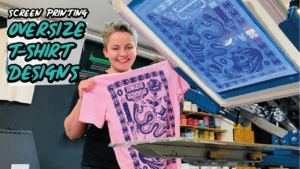
The Art of T-Shirt Printing – A Guide to Screen Printing Method
T-shirts are a classic and versatile piece of clothing that can be worn for any occasion. Customizing your own t-shirt design is becoming increasingly popular, as people look for unique ways to express themselves. One of the most popular methods for t-shirt printing is screen printing or silkscreen printing. In this article, we will explore the process of screen printing and its benefits for t-shirt printing.
What is Screen Printing?
Screen printing is a printing technique where ink is applied onto a fabric or material using a stencil and a mesh screen. The stencil is made up of a design that is cut out or printed onto a transparent film. The mesh screen is placed over the fabric, and the ink is pushed through the mesh using a squeegee. The ink is then transferred onto the fabric, creating a printed design.
The Screen Printing Process
Design Creation: The first step in screen printing is to create a design for the t-shirt. This can be done using graphic design software or by hand. Once the design is finalized, it is printed onto a transparent film.
Screen Preparation: The mesh screen is then prepared by coating it with a light-sensitive emulsion. The film with the design is placed onto the emulsion-coated screen and exposed to light. The light causes the emulsion to harden, except for the areas that were blocked by the design on the film.
Washing: The screen is then washed with water, removing the emulsion that did not harden. This creates a stencil on the mesh screen, which will be used to transfer the ink onto the fabric.
Printing: The screen is then placed onto the fabric, and ink is poured onto one end of the screen. A squeegee is used to push the ink across the screen, forcing it through the stencil and onto the fabric. The screen is then lifted off the fabric, leaving the printed design.

Benefits of Screen Printing for T-Shirt Printing
High-Quality Prints: Screen printing produces high-quality prints that are durable and long-lasting. The ink is absorbed into the fabric, creating a design that won’t fade or crack after multiple washes.
Versatility: Screen printing can be used on a wide range of fabrics and materials, including cotton, polyester, and even wood and metal.
Cost-Effective: Screen printing is cost-effective, especially for large orders. The more t-shirts you order, the cheaper the cost per shirt.
Customization: Screen printing allows for customization of t-shirt designs. Each shirt can have a unique design, making it perfect for events, businesses, or personal use.
Tips for Successful Screen Printing
Choose the Right Ink: Choose an ink that is suitable for the fabric you are using. Different types of ink work better on different fabrics.
Quality Screens: Use high-quality screens to ensure a clean and precise print.
Proper Drying Time: Allow enough time for the ink to dry before handling or washing the t-shirts. This will prevent smudging or fading of the design.
Keep it Simple: Avoid using too many colors or intricate designs, as this can make the printing process more difficult and time-consuming.
Conclusion
Screen printing is a versatile and cost-effective method for t-shirt printing. It allows for customization of designs and produces high-quality prints that are durable and long-lasting. By following the proper steps and tips, anyone can create their own custom t-shirts using the screen printing method.







